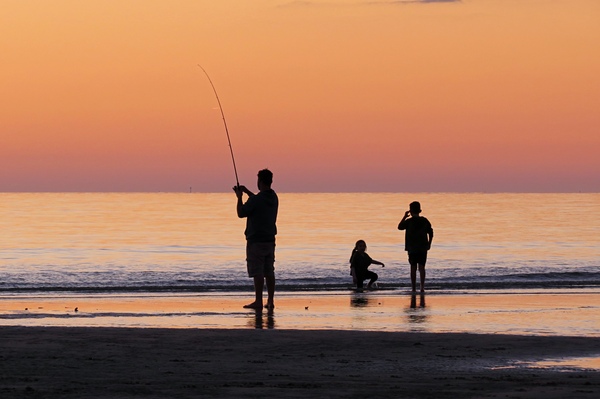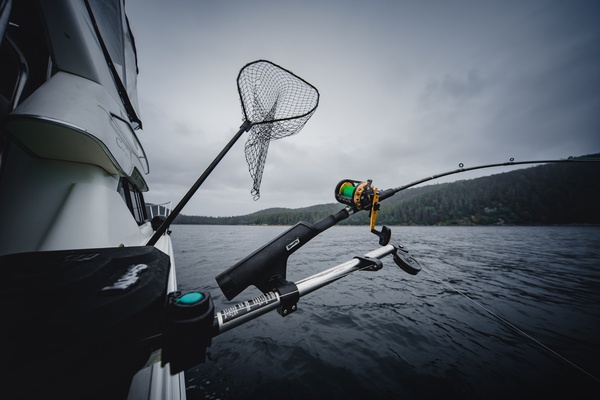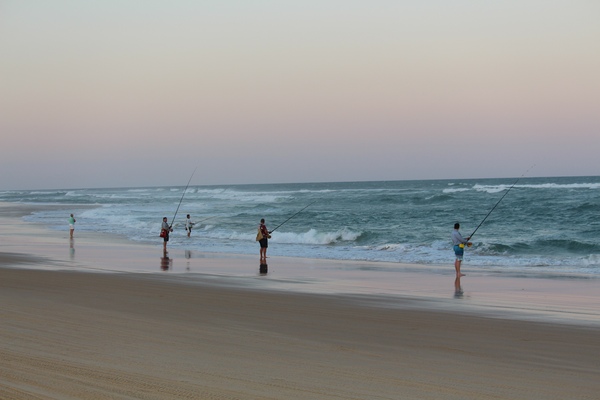
Dogfish and bull huss are two of the most common sharks found in UK waters. In this comprehensive guide, we will delve into their characteristics, explore the best locations to catch them, discuss the optimal times for fishing, reveal the ideal bait choices, provide effective fishing techniques, and offer valuable tips to enhance your angling experience. Whether you are a seasoned angler or a beginner, this guide will equip you with the knowledge you need to pursue and appreciate these fascinating creatures.
Check out the 5 best bass lures to use this summer – Read Now
Characteristics of Dogfish and Bull Huss
Dogfish, are slender, bottom-dwelling sharks that exhibit a more streamlined build compared to the larger and more powerful bull huss. Dogfish have a smooth greyish-brown skin with dark spots or small blotches, aiding in their camouflage. Bull huss, on the other hand, have rough skin with sharp denticles and a sandy brown to grey coloration, featuring distinct darker spots or blotches. Both species possess keen senses, including a strong sense of smell and excellent vision in low light conditions.
Where to Catch Dogfish and Bull Huss in the UK
To increase your chances of encountering dogfish and bull huss, it’s essential to know where they are commonly found in UK waters. While they can be encountered throughout the country, they are more commonly observed along the south and west coasts. Key locations for catching these sharks include the Isle of Wight, Cornwall, Devon, the Scottish coast (such as the Moray Firth and the Firth of Clyde), and the Irish Sea. These areas provide diverse habitats, ranging from rocky shores and sandy beaches to wrecks, offering ideal environments for dogfish and bull huss.
Planning on some plug fishing? Check out our guide
When to Catch Dogfish and Bull Huss

Timing is crucial when targeting dogfish and bull huss. While they can be caught year-round, the spring and autumn months present the best opportunities. In spring, dogfish and bull huss move inshore to spawn, congregating in shallower waters and increasing catch rates. Autumn, typically from September to November, sees these sharks migrating offshore to feed. They actively search for prey, following their favorite food sources into deeper waters. However, it’s important to note that local conditions and regional variations can influence their movements and behavior. Consulting local fishing reports and experienced anglers will provide valuable insights into the most productive times for catching them.
The river season presents a great opportunity for pike fishing – Our post will help you catch your PB – Catch up here
What Bait to Use for Dogfish and Bull Huss
Choosing the right bait is crucial for enticing dogfish and bull huss. These sharks have a preference for certain types of food, and using an appropriate bait can significantly increase your chances of success. Mackerel and squid are widely regarded as the best bait options for dogfish and bull huss. Their oily flesh and strong scent make them highly attractive to these sharks. Other suitable bait choices include herring and garfish, which share similarities in texture and scent with mackerel. Presenting the bait either dead or live can be effective, depending on your fishing technique and personal preference.
How to Catch Dogfish and Bull Huss

To effectively catch dogfish and bull huss, anglers employ various fishing methods and techniques. Let’s explore some popular approaches:
Bottom Fishing with Baited Hooks
This common method involves rigging a fishing line with baited hooks and casting it to the bottom. Using a sinker or weight to keep the line grounded, anglers wait for dogfish or bull huss to discover and strike the bait.
Mastering the Paternoster Rig for Bottom Fishing!
This rig is especially effective when targeting species like dogfish and bull huss. Let’s dive in and learn more!
What is the Paternoster Rig?
The Paternoster Rig is a versatile fishing setup designed to keep your bait close to the seabed, where these bottom-dwelling predators like to hunt. It consists of a mainline with a weight attached at the bottom and one or more hook-lengths branching off the mainline, allowing you to present multiple baits simultaneously.
Targeting Dogfish and Bull Huss
When aiming for dogfish or bull huss, consider using oily and fish-based baits to entice their appetite. Mackerel, squid, herring, and sandeel are popular choices that often yield great results. Ensure your bait is secure and can withstand the rigors of casting and retrieval.
Rigging the Paternoster Rig:
- Start by tying a swivel onto the mainline to prevent line twist.
- Attach a weight (such as a bomb or a lead) to the bottom of the rig. The weight will keep your baited hooks close to the seabed.
- Determine the desired length for your hook-lengths and tie them to the mainline using strong and reliable knots. You can use separate traces for each hook-length or a single length with droppers.
- At the end of each hook-length, tie on your hooks using appropriate knots. Make sure the hooks are sharp and suitable for the size of fish you’re targeting.
- Bait your hooks with fresh or frozen offerings, ensuring they are securely attached to withstand casting and bites.
Best Practices and Local Regulations
Always check local fishing regulations and size limits for dogfish and bull huss in your area before heading out. Respect the environment and release any undersized or protected species safely back into the water.
Get Ready to Reel ‘Em In!
Now that you’ve mastered the art of the Paternoster Rig, you’re armed with a powerful tool to target dogfish and bull huss. Remember, patience and perseverance are key in fishing, so be prepared to experiment with different baits, locations, and techniques. Tight lines and happy angling!
Drifting
Drifting is a technique where anglers allow their boat to drift naturally with the current while fishing. This method covers a larger area and increases the chances of encountering dogfish and bull huss. Anglers can employ drifting along productive areas such as tidal currents, channels, or drop-offs. Using baited hooks or jigs while drifting can entice strikes from these sharks.
Surfcasting

Surfcasting refers to fishing from the shoreline, where anglers cast their baited lines beyond the breaking waves to reach deeper waters. This method allows shore-based anglers to target dogfish and bull huss without the need for a boat. Choosing a suitable surfcasting rod, reel, and tackle, along with the right bait, enhances your chances of success in capturing these sharks from the shore.
Each fishing method has its advantages and suitability depending on the fishing location, prevailing conditions, and personal preferences. Experimenting with different techniques and adapting to the specific circumstances will help you refine your approach and increase your chances of a successful catch.
Tips for Catching Dogfish and Bull Huss
To optimise your fishing experience and increase your chances of catching dogfish and bull huss, consider the following tips:
Equip Yourself with a Strong Rod and Reel
Dogfish and bull huss are powerful fighters, so using a sturdy fishing rod and reel that can handle their strength is essential. Choose equipment designed for handling larger fish and capable of withstanding the stress of battling these sharks.
Match Bait Size to Target Species
When selecting bait, consider the size of the dogfish and bull huss you are targeting. Use bait that is proportionate to their feeding habits and mouth size. Adjusting your bait size can help increase your chances of enticing a bite.
Fish in Areas with a Good Supply of Baitfish
Identifying areas with an abundance of baitfish is crucial when targeting dogfish and bull huss. These sharks are opportunistic predators and are more likely to be present in areas where their preferred prey is plentiful. Look for signs of baitfish activity, such as diving birds, fish activity on the surface, or visible baitfish schools.
Be Patient and Observant
Dogfish and bull huss can exhibit slow feeding behaviors, requiring patience from anglers. Avoid rushing or constantly changing your bait or fishing spot. Instead, allow sufficient time for the sharks to locate and strike your bait. Maintaining a calm and observant approach will increase your chances of detecting subtle bites and responding accordingly.
Catching Dogfish and Bull Huss with Lures

While using baited hooks is a common and effective method for catching dogfish and bull huss, however some anglers have had success targeting these sharks with lures. Lure fishing allows for a more active and dynamic approach, enticing strikes through the movement and presentation of artificial imitations. Here are some tips for catching dogfish and bull huss with lures:
Selecting the Right Lures
When choosing lures for dogfish and bull huss, opt for those that resemble the prey species commonly found in their diet. Soft plastic lures in the shape of sand eels, small fish, or squid are popular choices. Consider lures with a realistic swimming action or ones that create vibrations and attract attention through their movement.
Casting and Retrieval Techniques
Cast your lure beyond the suspected location of dogfish or bull huss and allow it to sink to the desired depth. Retrieve the lure with a combination of steady reeling and occasional twitches or pauses to mimic the erratic movement of injured or fleeing prey. Experiment with different retrieval speeds and patterns to find what works best on a given day.
River Jig Fishing is great fun – Check out our guide
Time of Day and Conditions
Lure fishing for dogfish and bull huss can be particularly productive during low-light periods, such as early mornings, late evenings, or overcast days. These sharks tend to be more active during these times, increasing the likelihood of them responding to lures. Pay attention to water clarity and adjust lure color and size accordingly for optimal visibility.
Targeting Structure and Cover
Dogfish and bull huss often seek refuge near structures such as reefs, rock formations, or wrecks. Cast your lure close to these areas and work it along the edges or through crevices where the sharks might be lurking. Utilize the lure’s action to mimic injured prey seeking shelter, increasing the chances of attracting strikes.
Be Prepared for Strong Strikes
Dogfish and bull huss are powerful predators and can deliver strong strikes. Ensure that your fishing equipment, including rods, reels, and lines, are appropriately sized and capable of handling the force of a hooked shark. Maintain a firm grip on the rod and be prepared for a challenging fight once a shark is hooked.
Remember that lure fishing for dogfish and bull huss requires patience and experimentation. The effectiveness of specific lures and techniques can vary depending on various factors, including the location, season, and individual fish behavior. Stay observant, adapt your approach, and enjoy the excitement of enticing these sharks to strike your artificial offerings.
Conclusion: The Thrill of Fishing for Dogfish and Bull huss
Dogfish and bull huss offer exciting angling opportunities in UK waters. With their distinctive characteristics, abundance in certain regions, and the challenge they present, these sharks attract anglers seeking memorable fishing experiences. By understanding their behavior, selecting appropriate baits, utilizing various fishing techniques, and applying valuable tips, you can enhance your chances of successfully targeting and catching dogfish and bull huss. Remember to prioritize the conservation of these species, respecting fishing regulations, and cherishing the natural beauty of these remarkable creatures as you enjoy the pursuit of these prized catches. Happy fishing!
Why not check out our blog? Or subscribe to the newsletter to find out when a new post lands? You could win a free lure in our monthly giveaway!
Any other suggestions? Leave a comment below or get in touch
PZ
